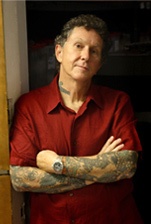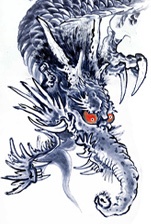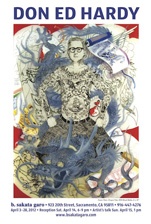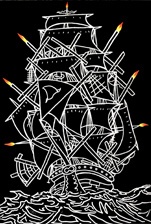ART INTERESTS
I had drawn avidly since the age of three, but my passion for art really began to focus at age sixteen, and became fascinated with the Beat scene in literature and jazz centered in San Francisco. I lucked across a great high school art teacher, Shirley Rice, who was a leftist New York Jewish intellectual, well read, hip and socially conscious. She told me I could do so much more than my surf art, turned me on to Picasso and introduced me to art with social consciousness. I started studying art history and getting more serious about what I wanted to do.
I was making all kinds of work and she encouraged me. She submitted a number of my pieces to something called the Scholastic Art Awards, a national competition for students. My work won more awards than anyone ever had before. My mother and Mrs. Rice took me to the awards ceremony in downtown Los Angeles. They gave me gold key awards, blue ribbons, and a tiny bit of money. I was in my total cool guy phase, all Peter Gunn with blazer, skinny tie, topcoat, and shined shoes supplanting my former surfer duds.
I surfed through senior year and when summer 1962 came, put my board away in the garage and began drawing obsessively. I told all my buddies that I was going to only make art. I knew I had to focus on this to get anywhere, and began voraciously reading art history. I was accepted to rent a booth for my work at the annual month-long Laguna Beach Festival of the Arts, a local institution since 1933. Over the course of the summer the art festival was an eye-opener for me on many levels. I met a lot of older artists, painters that were doing things, hipsters already living the life. One of the most exciting browsers I met in Laguna was Adele Ipsen, a Danish woma whose mother had modeled for my hero Munch. Impressed with my “homage to Munch” drawings, invited me to see her collection of Munch prints—it was stunning to feel so close to such a great historic artist. She also alerted me to some of my work’s similarity to George Grosz, so I looked into that.
Around the same time, I met Doug Hall, studying printmaking at Long Beach State, and his sister Martha and her friend Bonnie Russell, also doing graphics and painting. Martha’s boyfriend Richard Shaw and his pal Ken Conner were slightly older guys who painted but were primarily focused on expanding ceramic traditions.
We began investigating the Los Angeles art scene, driving up for the monthly openings. The early sixties offered an exciting, vibrant counterpoint to the established gallery scene in New York. Curator Walter Hopps and artist Ed Keinholz opened the Ferus Gallery in 1957, which became the entry point for many important new artists. Hopps was an eccentric visionary who became the greatest art curator of the twentieth century. In regular trips to the La Cienega galleries I was deeply affected by the works of John Altoon, Bruce Conner, Llyn Foulkes, Peter Voulkos, Bay Area figurative painters, and many others.
I was also interested in New York painting, abstract expressionism developed in the fifties, primarily de Kooning and Kline. Among the most riveting shows at the L.A. County Art Museum were retrospectives of Philip Guston and Jean Dubuffet. In Southern California there was so little awareness of art and so few serious collectors that younger artists without any expectations of being taken seriously in New York were free to follow paths of their own. They basically didn’t care about the East coast.
I began hearing more about San Francisco from my new friends, who decided that they were going to go to art school up north. So I found out about the San Francisco Art Institute and that became my destination.
Don Ed Hardy
Narratives
Don Ed Hardy recalls his time at the San Francisco Art Institute and his art interests. Read his interview in Juxapoz Magazine.
NEW PRINT
A Burial at Sea,
28"h. x 22"w.
Color lithograph, Edition of 20
View at Shark's Ink
© Don Ed Hardy – All Rights Reserved – Privacy Policy





